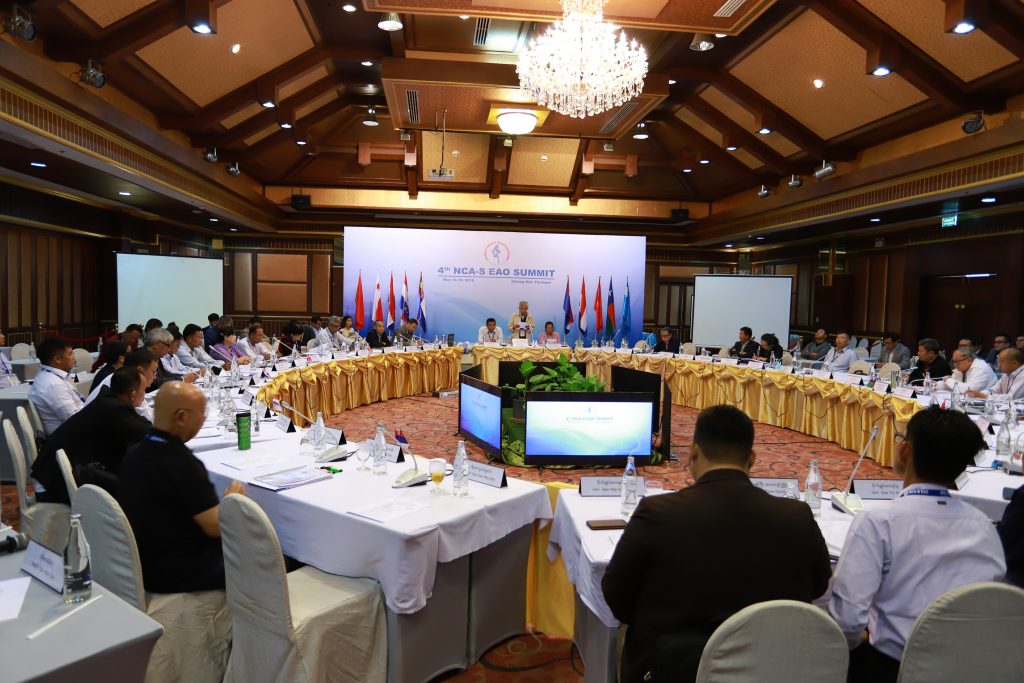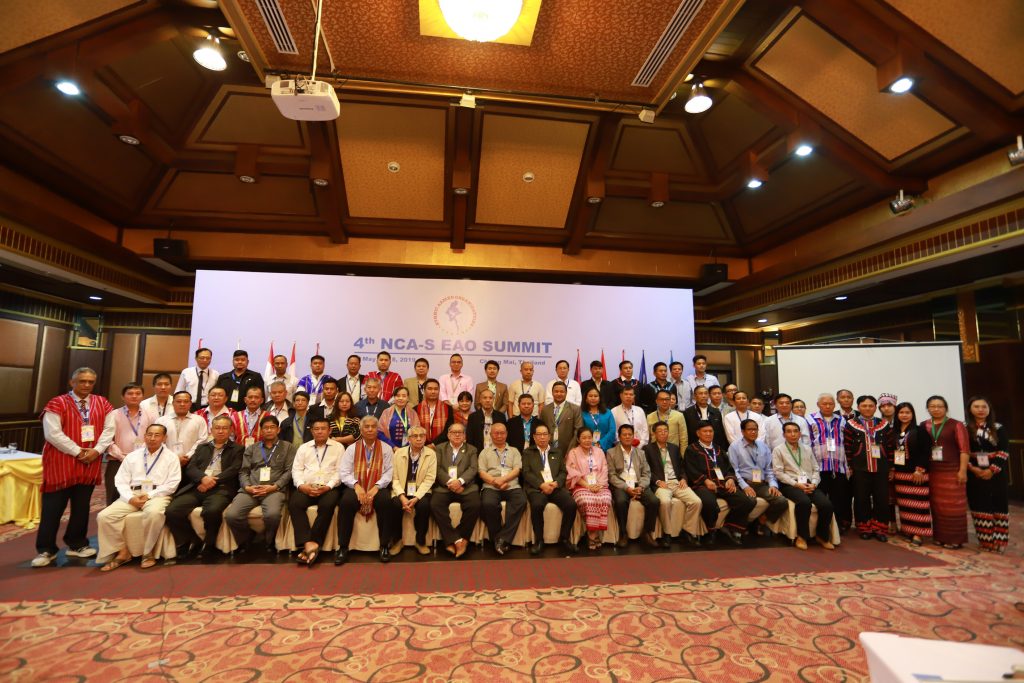The Karen National Union (KNU) proposed formation of new talk-shop dubbed as Peace Process Consultative Meeting (PPCM) aiming to include all Ethnic Armed Organizations (EAOs) and the disagreement, or rather not in tune with each other, between the government and the military or Tatmadaw, now seems to push the peace process negotiation that has started in 2011 back to square one.

The signing of Nationwide Ceasefire Agreement (NCA) in October 2015 by eight EAOs, later joined by another two in February 2018, and NCA-based peace negotiation process has now stalled since last November, as the two strongest, leading EAOs – KNU and Restoration Council of Shan State (RCSS) – opted out of the process, hinting unfairness and unequal decision-making power in implementation of the whole peace process vis-à-vis the government.
During the last NCA-Signatory-EAOs, officially abbreviated as NCA-S-EAO, meeting from May 14 to 18, KNU tendered its resignation, that still needs to be approved, from the Peace Process Steering Team (PPST), an advisory body that leads the group in peace talks with the government, and proposed to form a replacement with a new talk-shop PPCM that would include all EAOs, NCA signatories and as well the non-signatories. At this writing, the follow-up of May meeting which is scheduled to be held from June 5 to 10 is ongoing and probably will decide on two issues mentioned.
On the other hand, the government’s National Reconciliation and Peace Center (NRPC) which has been meeting with the four-member military front Northern Alliance-Burma (NA-B), whose troops are on war-footing with the Tatmadaw but a relative truce is now being maintained, due to the unilateral ceasefire of the Tatmadaw since last December which will end on June 30, to woo its members’ participation in the peace process by signing the NCA.
The NA-B, however, proposed to sign the bilateral ceasefire first, followed by the amendment of the NCA to be acceptable to them before it could finally sign it. The NRCP went along with the proposal, with Tatmadaw reluctantly going along, which is now at the stage of negotiation with drafts being delivered by all NA-B members at the end of April for government’s consideration. Recently, the government, in turn, announced that it also have proposed drafts ready for concerned parties to consider and working on the choice of meeting venue, which at this stage is not yet decided.

But the problem now seems to be the war in Arakan state between the Arakan Army (AA) and Tatmadaw that has been going on, ever since last December and heightened by former’s attacks on four police outpost on January 4, with no sign of de-escalation or stopping anytime soon. And as AA is member of the NA-B, other members, Kachin Independence Army (KIA), Ta’ang National Liberation Army (TNLA) and Myanmar National Democratic Alliance Army (MNDAA) or Kokang, will be reluctant to sign the bilateral ceasefire without AA involving, although it is true that the truce will be signed separately with each group and the Tatmadaw, a feeling of solidarity consideration is definitely high among the military alliance.
The Tatmadaw has made it clear that the truce with AA will be on the basis of its troops stationary in Laiza, Kachin state, where it has originated and not Arakan state where some of its troops are now operating and delivering earnest and fierce firefight with the Tatmadaw.
According to “Deciphering Myanmar’s Peace Process: A Reference Guide 2017-2018” published by Burma News International recently, which covers data up till end of March 2019, AA clashes with the Tatmadaw for 2017 counted 30 days; 2018 31 days; and 2019 until March only for 3 months 49 days.
The yearly armed clashes counted between all the EAOs and the Tatmadaw are: 2017 135 days; 2018 128 days; and 2019 until end of March 74 days.
Thus, the intensity of the AA and Tatmadaw military engagement could be seen as the heaviest, while clashes with the other EAOs were minimal and almost conflict free, due to the Tatmadaw’s unilateral ceasefire which has been in place since last December covering five military regions of Shan and Kachin states, excluding the Arakan state.
The Tatmadaw’s true news information team spokesman brigadier general Zaw Min Tun, on May 27 during the press conference at ministry of information, told the media that the AA stationing of its troops in Arakan state will not be considered as it has been a government controlled white area so far as the government is concerned and has to be forcibly evicted. In other words, the participation of the AA will only be on the basis of its troops stationary in Laiza, Kachin state, where it has started and the bulk of its troops, estimated to be 7000 in total, are still stationed.

On June 2, the Tatmadaw again reiterated its stance regarding the AA stationing in Arakan state as unacceptable.
Thus, the NRPC deliberation to get NA-B sign the bilateral ceasefire has been torpedoed even before starting.
While nobody knows for sure whether the Tatmadaw and National League for Democracy (NLD) government are on the same wavelength, where AA troops stationary position in Arakan state is accepted, the 2020 national election approaching fast. The military bloc, which includes the military-backed Union Solidarity and Development Party (USDP) and the 25 percent allotted, appointed Tatmadaw representative MPs within the parliament, are adversaries of the NLD and definitely on different political track if not on collision course.
For example everyone knows that the military bloc is against NLD’s constitutional amendment deliberations, which it has put it in motion through the parliament a few months ago, and is determined to protect the 2008 constitution at all cost, which have been made known time and again by the military commander-in-chief Min Aung Hlaing.
The NLD refusal to call the National Defense and Security Council meeting even once since the NLD came to power also irked and slighted the military, where of the 11 members, the commander-in-chief appointed 5 members and controls 6 votes besides serving as the highest authority in the government as an executive body.
Analysis
Given such development, the signing of bilateral ceasefire with the NA-B won’t be able to materialized, as AA stationary in Arakan state is rejected by the Tatmadaw and the AA commitment of its right as a necessity for it to be in its homestead to protect its people and its ancestor’s land. Even now the meeting place for ceasefire talks cannot be agreed upon as the NA-B wants it to happen in either Panghsang or Kunming, while the Tatmadaw insisted on places within its jurisdiction. An ex- military officer Dr Aung Myo who is now a political analyst told the media recently that the Tatmadaw might not be willing to go ahead with the bilateral ceasefire talks.
On the other hand, the NCA-S-EAO is now back to pre-NCA signing period, as it is in the process of dismantling the PPST, which is accepted by the government and Tatamdaw as body representing the the group for negotiation, and now trying to replace it with the PPCM that is neither a representative body of all EAOs nor an alliance that could make a collective decision on their behalf. Moreover, a working group to review the NCA, with an aim to amend it, involved 7 members with 3 non-signatory EAOs as members. A further step is said to be the formation of Peace Process Consultative Forum (PPCF), which the United Wa State Army (UWSA) sees it as positive, including the KIA. Thus, the situation is like when all the EAOs were meeting to find a common set of goals before signing the NCA with the government in October 2015.
The NLD and Tatmadaw although both are said to be under one roof of NRPC, the reality is that the Tatmadaw is a state within a state and bilateral ceasefire with the NA-B will only happen with its agreement. So far, it is not the case as the military doesn’t seem to be on the same wavelength with the NLD regarding the issue.
But consequently, it is also possible that NLD regime and the Tatmadaw have mutual understanding to exclude the AA and strive for its annihilation in Arakan state, while keeping the option of signing ceasefire for AA troops within Kachin state only, so that they will look good. But, of course, such a move will only be a non-starter.
In sum, with the gearing up the NCA signatories to scrap its peace negotiation body PPST by forming a new talk-shop PPCM for all EAOs, with the aim to look for common stance in bargaining with the government, the NCA-based peace process which is stalled since last November could be taken as virtually dead. The deliberations of bilateral ceasefire with the NA-B that could give impetus to peace-making and reconciliation is also bogged down by inflexible demands of the government and Tatmadaw, including total annihilation of the AA in Arakan state. Thus, unless all the stakeholders could consider the welfare big picture of the country as a whole and try to achieve political settlement through the motto of give-and-take that could lead to a win-win outcome, all will continue to muddle through in an endless vicious circle of conflict.




